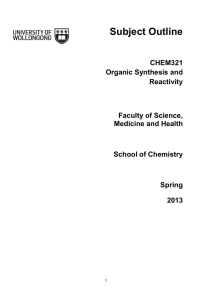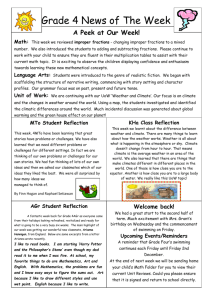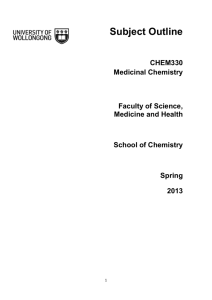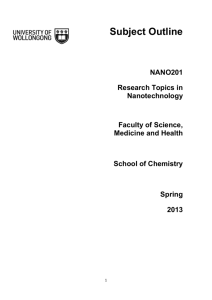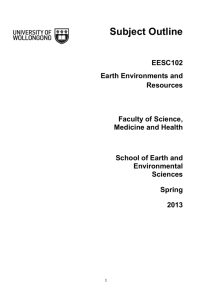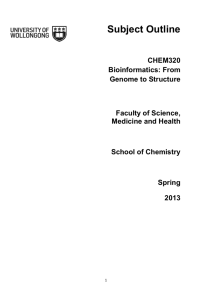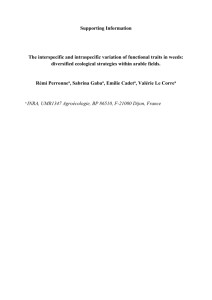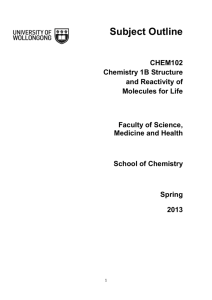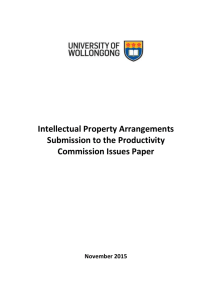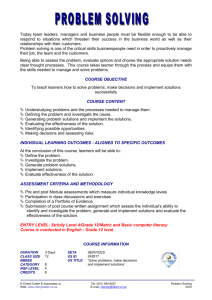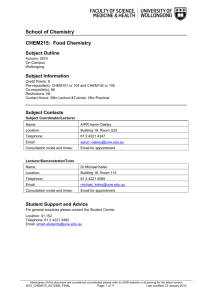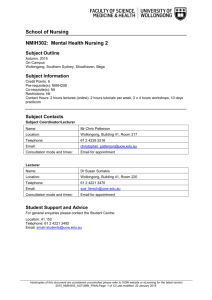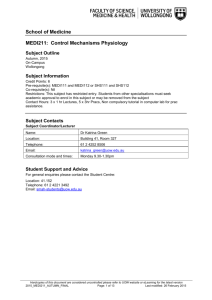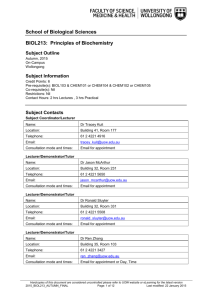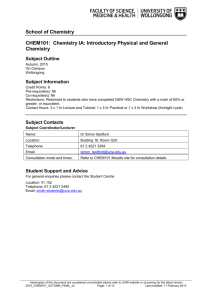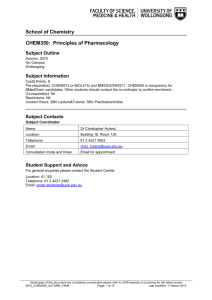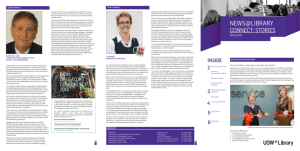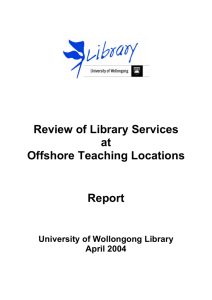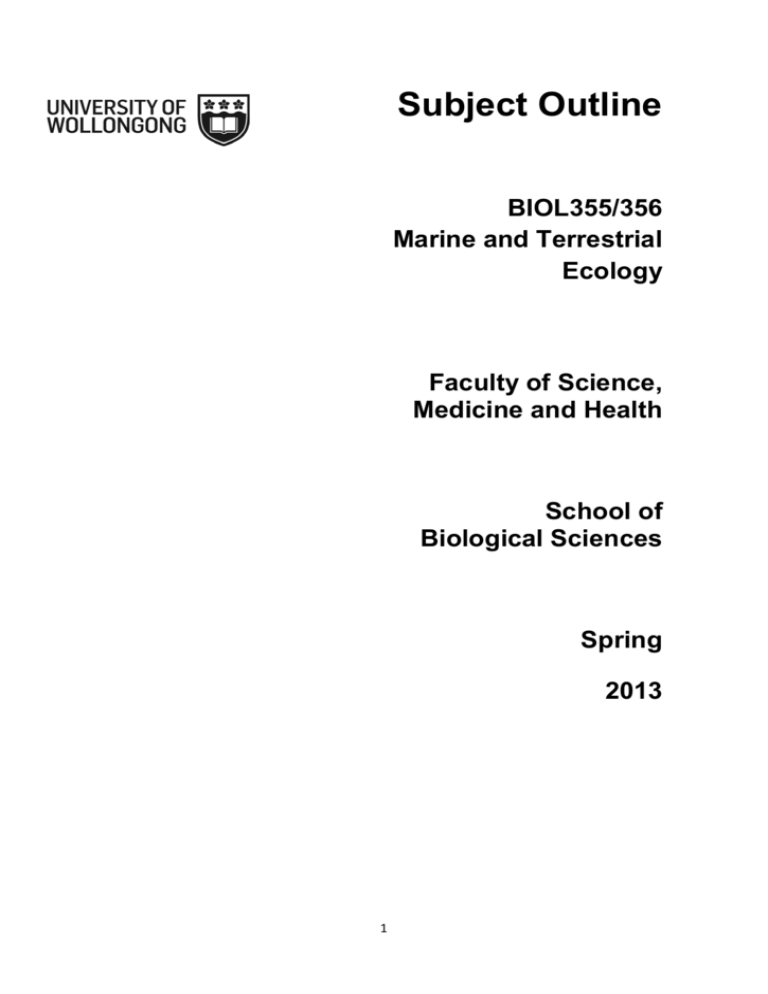
Subject Outline
BIOL355/356
Marine and Terrestrial
Ecology
Faculty of Science,
Medicine and Health
School of
Biological Sciences
Spring
2013
1
Subject Outline
Subject code:
BIOL355 & BIOL356
Subject name:
Marine and Terrestrial Ecology
Credit points:
8
Pre/co-requisites:
BIOL251 and STAT252
Mode of delivery:
On Campus
Delivery location:
Wollongong
© University of Wollongong 2013. All rights reserved.
Copyright and Disclaimer
No part of this work may be reproduced without the prior written consent of the University of Wollongong. All requests and
enquiries should be directed to the Vice-Principal (Administration), University of Wollongong, Northfields Avenue, Wollongong
NSW 2522 Australia. Within Australia telephone (02) 4221 3920; international +61 2 4221 3920.
http://www.uow.edu.au/about/disclaimer/index.html
The University of Wollongong attempts to ensure that the information contained here is correct at the time of production,
however, sections may be amended without notice by the University in response to changing circumstances or for any other
reason.
2
Contacts
Technical Officer
Name:
Prof Kristine French
Consultation mode and times:
_________________________________________________________________________
Lecturers
/Demonstators
Office
Phone
(4221)
Email
Kris French
35.G17
3655
kris@uow.edu.au
Phil Byrne
35.122A
1932
pbyrne@uow.edu.au
Consultation times
Wed 1.30-3.30
Fri 9.30-10.30
Tuesday 9.30-10.30
Friday 9.30-10.30
Justin Lathlean
justinl@uow.edu.au
Demonstrator
Russ McWilliam
ram923@uowmail.edu.au
Demonstrator
cmcomb@uow.edu.au
Technical Assistant
Christine McComb
42.101
3366
Faculty of Science, Medicine and Health
Location
41.152
Telephone
Email
61 2 4221 3492
smah_student_enquiries@uow.edu.au
3
Subject Information
Outline
Introduction to ecology - levels of organisation (individual, population, community,
ecosystem).
Experiments in ecology - their design, analysis and interpretation.
Biotic interactions: competition, herbivory, predation, mutualisms.
Disturbance, catastrophe and community structure and function.
Factors affecting species richness
Behavioural ecology and evolution: eco-evolutionary dynamics, life-history evolution,
conservation behaviour, behavioural syndromes, behavioural epigenetics.
Learning Outcomes
Through successful completion of this subject students will have:
a clear knowledge of experimental design and analysis of ecological experiments;
a familiarity with the ecology of marine and terrestrial ecosystems;
the ability to use a range of techniques to describe and investigate communities;
knowledge of the range of biotic and abiotic factors that determine community
structure and species richness;
an understanding of the nature of biotic interactions and their impacts on community
structure and function;
an understanding of how an animal’s behaviour contributes to its survival and
reproductive fitness, and how animals are adapted to their environments;
competence in the preparation of a scientific paper;
capacity to work in a group and
the ability to communicate results and ideas in verbal presentations.
Faculty Graduate Qualities
Valuable qualities gained by UOW graduates are essential for gaining employment and
making an important contribution to society and their chosen field – further information is
available at http://www.uow.edu.au/about/teaching/qualities/
Engagement in this subject will contribute to each student’s development of the following
UOW Graduate Qualities:
Informed
•
•
Comprehensive knowledge of an area of Science and well-developed skills in using
relevant technologies
Awareness of the international context in which advances in Science are made and
applied
Independent learners
•
•
Critical thinking skills
Scientific approach to the acquisition, analysis, and interpretation of data
4
Independence in seeking to extend knowledge through ongoing research, enquiry and
reflection
•
•
Problem solvers
Application of creative, logical and critical thinking to scientific problems
Effective communicators
•
•
Well-developed written, oral & aural communication
Effective collaboration and teamwork across a range of settings and cultures
Responsible
•
•
Ethical decision making
Respect for diverse opinions, professions, and cultures
5
Lecture/Tutorial/Laboratory Times
Refer to http://www.uow.edu.au/student/timetables/index.html for an up-to-date timetable.
Lectures:
Pracs:
Wednesday
Friday
10.30-12.30 19.1056
13.30-17.30 Weeks 1-3, 5
Weeks 4, 6-9
Weeks 10, 12
Weeks 11
17.105
41.172
19.1093, 24.204
15.206
Study Time
Students should note that UOW policy equates 1 credit point with 2 hours of study per week
that includes lectures and tutorials. For example, in a 6 credit point subject, a total of 12
hours of study per week is expected.
Recommended Readings
Krebs, C.J. (2009) Ecology. Benjamin Cummings, San Francisco.
Lindsay, D (1984) A Guide to Scientific Writing. Longman, Cheshire.
Zar, JH (1999) Biostatistical analysis. 4th Ed. Prentice Hall, New Jersey
Grafen, A and Hails, R. (2002) Modern statistics for the Life Sciences. Oxford Uni Press
Quinn, G.P. and Keough, M.J. (2002) Experimental Design and Data Analysis for
Biologists. Cambridge Uni Press
Underwood, A.J. (2002) Experiments in Ecology -their logical design and interpretation
using analysis of variance Cambridge University Press
The recommended readings are not intended as an exhaustive list and students should use
the Library catalogue and databases to locate additional resources.
e-Learning
This subject has materials and activities available via eLearning. To access eLearning you
must have a UOW user account name and password, and be enrolled in the subject.
eLearning is accessed via SOLS (student online services). Log on to SOLS and then click on
the eLearning link in the menu column.
For information regarding the eLearning spaces please use the following links:
Blackboard Vista - http://www.uow.edu.au/student/elearning/vista/index.html.
Moodle - http://uowblogs.com/moodlelab/files/2013/05/Moodle_StudentGuide-1petpo7.pdf
6
Lecture Schedule
Week
Lecture Wed 10.30-12.30, 19.1056
1 29/7
Recap on 2 factor ANOVA,
Adding factors
KF
Exp Design and analysis (KF)
Computer lab 17:105
2
ANCOVA
Mixed models
KF
Exp Design and analysis (KF)
Computer lab 17:105
3 12/8
Logistic regression
Multivariate analysis I
KF
Exp Design and analysis (KF)
Computer lab 17:105
4 19/8
Multivariate analysis II
Designing experiments
KF
FIELD TRIP (KF/PB) 23-25th
5
26/8
Interactions and community
structure
KF
Computer lab 17:105
Project preparation. Room 41.
172 (KF/PB)
6
2/9
Equilibrium and non-equilibrium
Communities
KF
Projects
7 9/9
Species Diversity in Ecological
Communities
KF
Projects
8
Ecosystem dynamics
PB
Projects
Eco-evolutionary dynamics
PB
Projects
5/8
16/9
9 23/9
30/9
Practical Fri 1.30-5.30
Assignments
due
Statistics 1
Statistics 2
Field camp
report
Mid-Session Break
10 7/10
Life History Evolution
PB
Paper discussion (PB)
11 14/10
Animal Behaviour in a changing
world
PB
Paper discussion (PB)
12 21/10
Integrating Animal Behaviour and
Conservation Biology
PB
13 28/10
Advances in Behavioural Ecology
PB
7
Seminars (KF/PB)
Project reports
Assessment
Minimum performance requirements
Students need to complete each component at the level specified.
Component
Final Examination
Minimum Standard
45%
Overall
50%
Students who do not meet the minimum performance requirements as set out in the Subject
Outline may be given a Fail grade or TF (Technical Fail) grade on their Academic Transcript.
See
the
General
Course
Rules
at
http://www.uow.edu.au/handbook/generalcourserules/index.html
Summary
Task
Title
Assignment
Assignment
Assignment
Seminar
Report
Examination
Weighting
Statistics 1
Statistics 2
Field Camp
Project Seminar
Project
Final Exam
Due Date
13th August
28th August
17th September
18th October
25th October
5%
5%
15%
10
25%
40%
Performance grades
HD
High Distinction
85–100%
D
Distinction
75–84%
C
Credit
65–74%
P
Pass
50–64%
PS
Pass Supplementary
50%
F
Fail (unsatisfactory completion)
0–49%
TF
Technical Fail
No mark recorded
8
Scaling
Marks awarded for any assessment task (including examinations) may be subject to scaling
at the end of the session by the Unit Assessment Committee and/or the Faculty Assessment
Committee (FAC). Marks will only be scaled to ensure fairness/parity of marking across
groups of students. Scaling will not affect any individual student’s rank order within their
cohort. For more information refer to Assessment Guidelines – Scaling
http://www.uow.edu.au/about/policy/UOW058609.html
Submission and Return of Assessment Items
Submit all written assignments to SMAH Central (see below).
Students are advised to keep an electronic or hard copy of all submitted assessment tasks
except in circumstances where this is not possible e.g. where the task is submitted at the
end of activity in which it was completed.
Submitting an assignment at SMAH Central
Assignments submitted at SMAH Central MUST have a SATS (Student Assignment
Tracking System) coversheet attached to the front of the assignment. Instructions for
generating a coversheet can be found on the SMAH Central web page.
For an assignment to be successfully submitted at SMAH Central please note the following:
•
•
•
•
The coversheet must be signed and dated
The assignment must have the correct coversheet i.e. the correct subject code and
tutorial group (if applicable)
A legible barcode with all numbers and digits below e.g. UOW20121007656
Assignments must be submitted by 2.30pm on the due date
If an assignment is submitted to SMAH Central without any of the above we will contact you
and advise that you need to return to SMAH Central with the correct coversheet. Your
assignment won’t be recorded as being submitted until the correct coversheet is attached.
This might mean that the assignment is recorded as being submitted late.
Assessments will be returned through SMAH Central. Uncollected assessment tasks will be
destroyed 21 days after the release of marks for that session
Late Submission
All assessment tasks are to be submitted on the due dates as specified in this Subject
Outline. Assessment tasks submitted late will be penalised by the deduction of 10% of the
maximum possible mark for the assessment task per calendar day or part thereof. Deduction
of marks will not result in a negative mark.
Note that assessment tasks submitted to SMAH Central must be submitted by 2:30 pm on
the due date to guarantee being recorded in SATS as being submitted on time.
9
Academic Consideration including Extensions of Time
Applications from students for academic consideration should be made only on the grounds
of serious or extenuating circumstances. Applications for academic consideration are
governed by the University’s Student Academic Consideration Policy at
http://www.uow.edu.au/about/policy/UOW058721.html
Do not assume that an application for special consideration will be automatically granted.
Supplementary Assessments
Supplementary assessment may be offered to students who receive a mark of 48% or 49%,
and are otherwise identified as meriting an offer of a supplementary assessment. The form
of supplementary assessment will be determined at the time the offer of a supplementary
assessment is made. For more information refer to the Supplementary Assessment
Guidelines
http://www.uow.edu.au/content/groups/public/@web/@gov/documents/doc/uow112335.pdf.
Note that if you are offered a supplementary examination as the supplementary assessment
that you will need to sit the examination in the supplementary examination period.
Referencing
The Harvard referencing system is used in Biol 355/356 – this is also known as the authordate system due to the order of the information presented. Failure to document adequately
and fully is to ignore scholarly rules – and run the risk of plagiarism.
Please
consult
the
UOW
library
website
for
further
information:
http://public01.library.uow.edu.au/refcite/style-guides/html/
Plagiarism
Students are responsible for submitting original work for assessment, without plagiarising or
cheating, abiding by the University’s policy on plagiarism as set out in the University
Handbook under the University’s Policy Directory. Plagiarism has led to expulsion from the
University.
The University’s Academic Integrity and Plagiarism Policy, Faculty Handbooks and subject
guides clearly set out the University’s expectation that students submit only their own original
work for assessment and avoid plagiarising the work of others or cheating. Re-using any of
your own work (either in part or in full) which you have submitted previously for assessment
is not permitted without appropriate acknowledgement. Plagiarism can be detected and has
led to students being expelled from the University.
The use by students of any website that provides access to essays or other assessment
items (sometimes promoted as ‘resources’) is extremely unwise. Students who provide an
assessment item (or provide access to an assessment item) to others, either directly or
indirectly (for example by uploading an assessment item to a website) are considered by the
university to be intentionally or recklessly helping other students to cheat. This is considered
academic misconduct and students place themselves at risk of being expelled from the
University.
http://www.uow.edu.au/about/policy/UOW058648.html
10
Assessment Tasks
_________________________________________________________________________
Task:
FIELD CAMP – August 23-25th
Due Date:
Field camp report, 17th September
Weighting:
15%
Cost:
$80
There will be a compulsory field trip during the 4th week of session. On the field trip, you will
conduct a set of studies designed to familiarize you with several techniques essential to the
study of ecology. Data collected in this session will be used to analyse and write up a
statistical experimental design assignment
We will depart from the Uni. at 12.30 pm on the Friday and return on Sunday afternoon at
around 5 pm.
Food, accommodation etc.
Your travel will be provided free of charge. You will pay in advance for the food and
accommodation at the field station, so start saving up. The subject Technical Officer will be
doing all the arranging in the first couple of weeks of the session. You will be required to
help prepare, cook and cleanup after each meal during the camp,as well as collect and
collate your data.
What to bring?
It always rains on field camps, so come prepared. You will not only need enough rain gear to
keep you dry, and dry clothes to change into afterwards, but you will also need to be able to
take notes in the wet. How about getting some waterproof paper? Bring pencils rather than
ballpoints. The work we will do might include night sampling. Bring a torch, head-torch,
miner's lamp, spotlight or other source of photons. Also bring plenty of batteries.
You will get some time to sleep during the camp, so a sleeping bag will be necessary and
sheet and pillow case to prevent contagious diseases.
11
Task:
RESEARCH PROJECTS
Due Date:
Research project report, 25th October
Weighting:
25%
Working in groups
You will work in groups of (max) three for your project. To encourage teamwork in your
groups, your final report will be a combination of group and individual efforts. Your group will
be responsible for producing plots and analysing your data. The remainder of the report (i.e.
all written material) MUST be an individual (i.e. your own) effort.
Preliminary discussions
You should read some of the literature before you talk to your group about the methods you
will use, so that you are familiar with some techniques and questions. A practical has been
set aside for you to discuss your choice of project with your supervisor – either a lecturer or
demonstrator. Also discuss your ideas with other ecologists in the School - it will help
consolidate your thoughts. This time is then available each week to discuss and update your
supervisor about problems. Demonstrators and lecturers will be available from 1.30-2.30pm
on Friday each week to talk through problems (or after tutorials when we have them). Apart
from this, demonstrators will not be available at other times and lecturers will only be
available during their consultation hours. You must attend the meeting each Friday
unless you have prior arrangements with your supervisor – it will form part of the
mark they will allocate to you for effort.
Style of the report
Your project report MUST be modelled on the style of a paper in Austral Ecology. This
paper has a word-limit of 3,000 words; shorter if you wish. Please be imaginative in
presenting your results. There must be a text component to the results section, and data are
often better presented in graphs, histograms etc. than as tables. The results text must be
self explanatory, and the figures/tables should be sufficiently clear to stand alone. For
guidance, read the appropriate sections of Lindsay's book, A Guide to Scientific Writing and
refer to recent articles in Austral Ecology.
I would expect at least 10 references to journal articles of relevance to be used in the write
up. Textbooks, encyclopedias and websites are not acceptable as references. You must
use primary literature.
Criteria for assessment:
Each member of your group is expected to spend at least 15 hours collecting data (5 weeks
x 3hrs). You should expect to spend an additional 15 hours analyzing and interpreting your
data, and preparing the final report. The effort you put into your data collection will be
reflected in your report mark – 20% of the final report mark will be allocated to effort which
includes your weekly meetings. Note the allocation of marks below.
12
Effort
20%
Experimental Design
15%
Writing Style
10%
Analysis
20%
Interpretation
25%
Scientific Layout
10%
Total
100%
Seminar
You will give seminars on your projects. This will probably be a 10-minute presentation, with
5 minutes for questions for each group. The time available will depend on the number of
students in the subject - we will clarify time available for seminars early in the session. A
guide to seminars and how to give them is in Lindsay's book.
13
DATAFILE SUMMARY
This is a summary of the experiments behind each dataset within each excel spreadsheet.
The data are completely rubbish, not associated with reality; except that the questions and
experimental design are valid ones i.e. don’t assume something true from the results. They
are meant as examples only.
Lizard
Broad aim of research: to investigate the effect of diet on weight gain in a species of lizard.
Experimental design: Thirty lizards were given one of 3 diets. Ten were given a diet low in nitrogen
(diet 1), 10 were given a diet with moderate nitrogen, similar to insect composition (Diet 2), 10 were
given a diet with very high nitrogen (Diet 3).
Wood
Broad aim of research: to determine the relationship between trunk diameter and yield of wood in a
commercial eucalypt
Experimental design: 14 trees had their trunk diameters measured before being cut down and yield of
wood measured
Birds
Broad aim of research: to determine if forest density is related to bird abundance.
Experimental design: At fifteen sites in northern NSW the number of birds in 10 ha was measured.
The number of trees over 50cm in diameter was also measured as a indicator of forest density
Frogs
Broad aim of research: to understand the relationship between call rate and temperature for frogs in
ponds near Gosford (or any other town if you want!)
Experimental design: over 15 nights, 15 different ponds in the area were visited and the call rate per
0.1ha area was measured for 15 minutes. The temperature at the time of sampling was also
recorded.
PhD
Broad aim of research: to determine competition between closely related rodents in forests
Experimental design: At 5 sites, sampling was undertaken to determine the abundance of two species
of rodents.
Rainforest
Broad aim of research: to investigate the effect of plant size and nearness to a gap on fruit removal of
a rainforest tree
Experimental design: Fruit removal was measured on 9 small, 9 medium and 9 large plants. Three
of each plant size was located in gaps, 3 were near a gap and 3 were distant from gaps in the interior
of the rainforest.
Weeds
Broad aim of research: to investigate flower production for 3 species of shrubs in weed infested areas
on different soil types.
Experimental design: Weed infested and natural sites were chosen on sandstone and on shale. For
each of these 4 sites, the flower production on 6 plants of each of 3 species was measured through
the flowering season.
14
Butterflies
Broad aim of research: To investigate differences in size of male and female caterpillars of the
Scarlet-tipped butterfly
Experimental design: At a range of sites of different latitudes, the final size at pupation for 40
caterpillars was measured. The sex of each caterpillar was recorded when butterflies hatched from
pupae. At each site the average daily maximum temperature was measured using temperature dataloggers.
Smoke
Broad aim of research: To investigate the effects of smoke and heat on the rate of germination of a
plant species
o
Experimental design: Seeds of a plant species underwent one of 4 heat treatments: 25 C (200
o
o
o
seeds), 40 C (200 seeds), 80 C (200 seeds), 120 C (200 seeds). Half the seeds within each heat
treatment were then treated with smoke water, and half were just given plain water. Seeds were
divided into 5 petri dishes (each of 20 seeds) and placed in an incubator. Seed germination was
measured after 2 months.
Fertiliser
Broad aim of research: to investigate the effect of 3 different fertilisers on yield in a commercial crop.
Experimental design: To each of ten pots of the commercial crop (each planted with the same weight
of seed), one of 3 different fertilisers were added regularly and the yield measured by weighing the
above ground biomass after 10 weeks. A control set was also measured which received no fertiliser
(Group 1).
Logging
Broad aim of research: to investigate the effect of different logging regimes on the abundance of small
mammals.
Experimental design: On one side of a mountain, 3 areas were set up. A different logging regime was
applied to each area. A control plot was set up across the creek on the other side of the valley. In
each site, 5 transects of Elliott traps were sampled to determine mammal abundance.
Reef
Broad aim of research: to investigate the effect of 4 different species of nudibranchs on the cover of
algae on reefs.
Experimental design: To each of 4 small reefs within a lagoon on a coral island, four cages were set
up. Into each cage was placed 4 individuals of a species of nudibranch. Cover of algae was
measured after 4 weeks.
Western NSW
Broad aim of research: To investigate the effect of fragmentation on spider abundance.
Experimental design: In each of 6 regions in western NSW, one narrow, one small and one medium
fragment was chosen. In each fragment, spider abundance was measured in 3 sites on the edge of
the fragment and 3 sites in the interior.
Westloss is the same data, but data have been lost.
Tadpoles
Broad aim of research: To investigate the effect of reed density on the abundance of tadpoles.
Experimental design: Twenty four ponds were sampled for tadpoles. Eight ponds had a low, eight
had moderate and 8 had a high density of reeds. Pond size was measured for each pond and
abundance estimated as a density per unit area.
15
Saplings
Broad aim of research: to investigate the relationship between growth and watering regime in saplings
Experimental design: 40 saplings were given one of 4 different watering regimes and their growth
after 2 year was recorded. Initial height of each sapling was recorded prior to the experiment.
Platform
Broad aim of research: to investigate the changes in diversity with height on the shore
Experimental design: At 4 rock platforms in the Illawarra, the number of species was counted in
quadrats at each of three heights on the shore.
Nectar
Broad aim of research: to investigate whether nectar production varies in plants in watered versus
unwatered gardens.
Experimental design: Three plants from each of a watered and an unwatered garden were sampled.
On each plant, 6 inflorescences were chosen and the amount of nectar in 5 flowers within each
inflorescence were measured.
16
General Advice
Students should refer to the Faculty of Science, Medicine and Health website for information
on policies, learning and support services and other general advice.
Use of Electronic Devices in Timetabled Activites
Ensure that mobile phones are turned off or turned to silent before timetabled activities.
Electronic devices including mobile phones and portable MP3 players should not be
accessed during timetabled activities unless otherwise advised.
17


